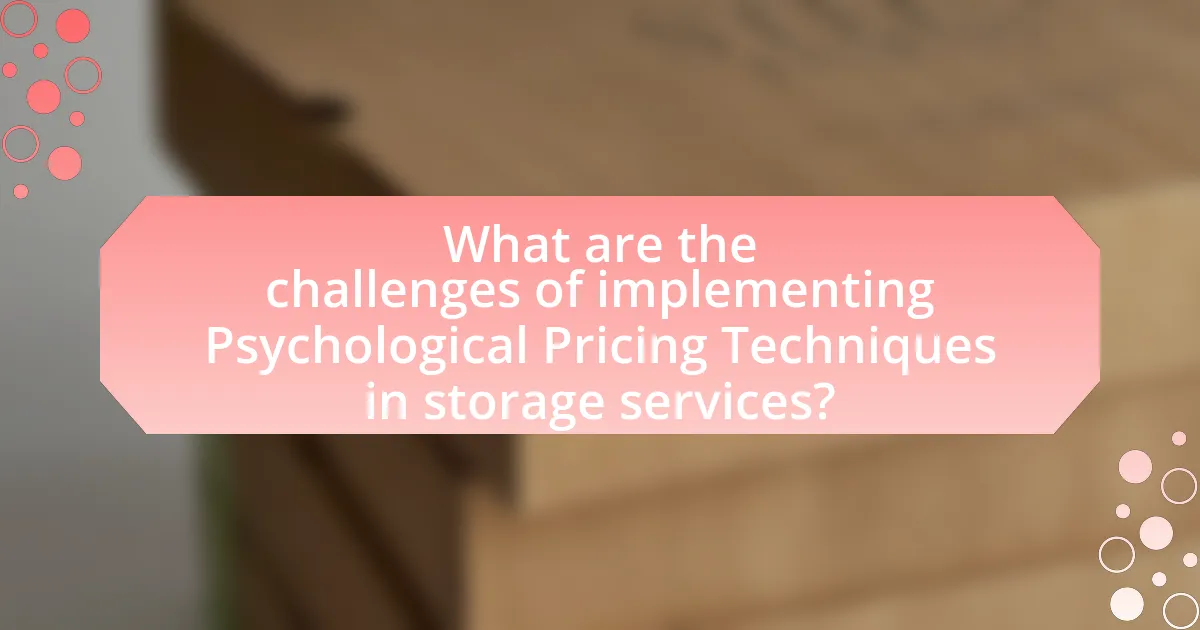Psychological pricing techniques for storage services are strategies designed to influence consumer perception and decision-making regarding pricing. Key techniques include charm pricing, where prices are set just below a round number, tiered pricing that offers multiple service levels, and price anchoring that presents a higher-priced option first to enhance perceived value. These methods leverage cognitive biases to drive consumer behavior, making storage services appear more affordable and attractive. The article explores how these techniques impact consumer choices, the principles behind them, their application in the storage industry, and the challenges and best practices for effective implementation.
What are Psychological Pricing Techniques for Storage Services?

 |
|
Psychological pricing techniques for storage services include strategies that influence consumer perception and decision-making regarding pricing. One common technique is charm pricing, where prices are set just below a round number, such as $99.99 instead of $100, making the service appear more affordable. Another technique is the use of tiered pricing, which offers multiple service levels at different price points, encouraging customers to choose a higher-priced option that seems to provide better value. Additionally, anchoring involves presenting a higher-priced option first, making subsequent lower-priced options seem like better deals. These techniques are effective because they leverage cognitive biases, such as the tendency to perceive prices ending in .99 as significantly lower than they are, and the influence of initial price exposure on perceived value.
How do Psychological Pricing Techniques influence consumer behavior?
Psychological pricing techniques significantly influence consumer behavior by leveraging cognitive biases to encourage purchasing decisions. For instance, pricing strategies such as charm pricing, where items are priced just below a round number (e.g., $9.99 instead of $10), create a perception of value and affordability, leading consumers to feel they are getting a better deal. Research indicates that consumers are more likely to purchase products that are priced in this manner, as it triggers a psychological response that makes the price seem lower than it actually is. Additionally, techniques like price anchoring, where a higher initial price is presented alongside a discounted price, can enhance the perceived value of the offer, prompting consumers to act quickly to take advantage of the perceived savings. These strategies are effective in storage services, where competitive pricing can sway consumer choices and drive sales.
What are the key principles behind Psychological Pricing?
The key principles behind Psychological Pricing include the use of pricing strategies that influence consumer perception and behavior. These principles often involve setting prices just below a round number, such as pricing an item at $9.99 instead of $10, which creates a perception of a better deal. Additionally, anchoring is a principle where a higher initial price is presented to make subsequent prices seem more attractive, as seen in the use of reference pricing. Research indicates that consumers are more likely to purchase products when they perceive them as being on sale or discounted, reinforcing the effectiveness of these pricing strategies.
How do these principles apply specifically to storage services?
Psychological pricing techniques apply to storage services by influencing customer perception and decision-making through strategic pricing structures. For instance, using charm pricing, where prices end in .99, can make storage units appear more affordable, thereby increasing customer interest. Additionally, tiered pricing models can create a sense of value, encouraging customers to choose higher-priced options that seem to offer more benefits, such as larger unit sizes or additional features. Research shows that consumers often associate lower prices with better deals, which can drive higher occupancy rates for storage facilities.
What types of Psychological Pricing Techniques are commonly used in storage services?
Common psychological pricing techniques used in storage services include charm pricing, price anchoring, and tiered pricing. Charm pricing involves setting prices just below a round number, such as $99.99 instead of $100, which can create a perception of a better deal. Price anchoring presents a higher initial price alongside a discounted rate, making the latter seem more attractive. Tiered pricing offers multiple service levels at different price points, encouraging customers to choose a mid-range option that appears to provide the best value. These techniques leverage consumer psychology to influence purchasing decisions effectively.
What is charm pricing and how is it applied in storage services?
Charm pricing is a pricing strategy that involves setting prices just below a round number, typically ending in .99 or .95, to make the price appear lower than it actually is. In storage services, charm pricing is applied by pricing units at amounts like $99.99 instead of $100, which can psychologically influence customers to perceive the service as more affordable. Research indicates that consumers often associate prices ending in .99 with discounts or better deals, leading to increased sales and customer engagement in the storage industry.
How does price anchoring work in the context of storage services?
Price anchoring in the context of storage services involves presenting a higher initial price to create a reference point, influencing customers’ perception of value. This technique leverages the psychological tendency of consumers to rely heavily on the first piece of information they encounter when making decisions. For instance, if a storage company advertises a premium unit at $200 per month alongside a standard unit priced at $150, the higher price serves as an anchor, making the standard unit appear more affordable and attractive. Research indicates that consumers often judge the value of a service based on the initial price they see, which can significantly impact their purchasing decisions.
What role does decoy pricing play in attracting customers to storage services?
Decoy pricing plays a significant role in attracting customers to storage services by creating a comparative framework that makes certain options appear more appealing. This pricing strategy involves offering a third option, or “decoy,” that is intentionally less attractive than the desired choice, thereby steering customers towards the more profitable option. For instance, if a storage company offers a small unit for $50, a medium unit for $100, and a decoy large unit for $150 that lacks significant advantages, customers are more likely to choose the medium unit, perceiving it as a better value. Research indicates that decoy pricing can increase sales by up to 30% by influencing consumer perception and decision-making processes.
Why are Psychological Pricing Techniques effective for storage services?

 |
|
Psychological pricing techniques are effective for storage services because they leverage consumer behavior to create perceived value and encourage purchasing decisions. For instance, pricing strategies such as charm pricing, where prices are set just below a round number (e.g., $99.99 instead of $100), can make storage options appear more affordable and attractive. Research indicates that consumers often associate lower prices with better deals, leading to increased sales. Additionally, offering tiered pricing can create a sense of urgency and exclusivity, prompting customers to choose higher-priced options that they perceive as providing greater value. This approach is supported by studies showing that consumers are more likely to select options that they believe offer a psychological advantage, such as perceived savings or enhanced service quality.
What psychological factors contribute to the effectiveness of these techniques?
Psychological factors that contribute to the effectiveness of psychological pricing techniques for storage services include perceived value, anchoring, and scarcity. Perceived value influences customers’ willingness to pay by creating a sense of worth associated with the service, often enhanced through strategic pricing that suggests quality. Anchoring occurs when initial price points set a reference for customers, making subsequent prices seem more attractive; for example, displaying a higher original price next to a discounted rate can lead to increased sales. Scarcity, or the perception that a service is limited in availability, can create urgency, prompting quicker decision-making and purchases. Research by Cialdini (2009) in “Influence: Science and Practice” supports these factors, demonstrating how they effectively drive consumer behavior in various markets.
How does perceived value impact customer decisions in storage services?
Perceived value significantly influences customer decisions in storage services by shaping their willingness to pay and choice of provider. When customers believe that the benefits of a storage service, such as security, accessibility, and customer support, outweigh the costs, they are more likely to select that service. Research indicates that 70% of consumers consider perceived value as a critical factor in their purchasing decisions, particularly in service-oriented industries. This perception can be enhanced through effective marketing strategies, such as highlighting unique features or offering promotions, which further solidifies the customer’s belief that they are receiving a good deal.
What is the significance of scarcity and urgency in pricing strategies?
Scarcity and urgency are significant in pricing strategies as they create a psychological trigger that compels consumers to act quickly. When products or services are perceived as limited in availability or time-sensitive, customers are more likely to make impulsive purchasing decisions to avoid missing out. Research indicates that the fear of missing out (FOMO) can increase conversion rates by up to 30%, demonstrating the effectiveness of these techniques in driving sales. By leveraging scarcity and urgency, businesses can enhance perceived value and encourage immediate action, ultimately leading to increased revenue.
How do Psychological Pricing Techniques affect competition in the storage industry?
Psychological pricing techniques significantly influence competition in the storage industry by creating perceived value and driving consumer behavior. These techniques, such as pricing just below a round number (e.g., $99.99 instead of $100), can make storage services appear more affordable, attracting price-sensitive customers. Research indicates that businesses employing psychological pricing often see increased sales volume, as consumers are more likely to choose options that seem less expensive due to these pricing strategies. For instance, a study published in the Journal of Marketing Research found that consumers are more likely to purchase products priced at $9.99 compared to those priced at $10, demonstrating the effectiveness of such techniques in influencing purchasing decisions. Consequently, storage companies that utilize psychological pricing can gain a competitive edge by appealing to consumer perceptions, potentially leading to increased market share and profitability.
What strategies can storage companies use to differentiate themselves through pricing?
Storage companies can differentiate themselves through pricing by implementing tiered pricing structures that cater to various customer needs and budgets. This strategy allows companies to offer multiple service levels, such as basic, standard, and premium options, which can attract a wider range of customers. For instance, a study by the Journal of Marketing Research indicates that tiered pricing can increase perceived value and customer satisfaction, as it provides choices that align with individual preferences. Additionally, storage companies can utilize charm pricing, setting prices just below a round number (e.g., $99.99 instead of $100), which has been shown to enhance the attractiveness of offers and encourage purchases. By combining these strategies, storage companies can effectively position themselves in a competitive market while appealing to diverse consumer psychology.
How can understanding competitor pricing enhance a storage service’s pricing strategy?
Understanding competitor pricing allows a storage service to strategically position its own pricing to attract customers while maximizing profitability. By analyzing competitors’ pricing models, a storage service can identify market trends, customer expectations, and price elasticity, enabling it to set competitive rates that appeal to potential clients. For instance, if competitors offer similar services at lower prices, the storage service can either adjust its pricing or enhance its value proposition through additional features or superior customer service. This approach is supported by research indicating that businesses that monitor competitor pricing can increase their market share by up to 10% through effective pricing strategies.
What are the challenges of implementing Psychological Pricing Techniques in storage services?

 |
|
Implementing Psychological Pricing Techniques in storage services faces several challenges, including customer perception, market competition, and pricing strategy alignment. Customer perception can hinder effectiveness, as clients may not respond positively to prices that seem artificially low or high, leading to skepticism about service quality. Market competition poses another challenge, as competitors may offer more straightforward pricing models, making it difficult for storage services to justify psychological pricing strategies. Additionally, aligning pricing strategies with operational costs and service value can complicate the implementation process, as businesses must ensure that psychological pricing does not compromise profitability or service quality.
What common pitfalls should storage service providers avoid?
Storage service providers should avoid underpricing their services, as it can lead to perceived low value and unsustainable business practices. Underpricing often results in a customer base that expects discounts and may not appreciate the quality of service provided. Additionally, providers should steer clear of failing to communicate the benefits of their pricing structure, as unclear pricing can confuse customers and diminish trust. Research indicates that transparent pricing strategies can enhance customer satisfaction and loyalty, reinforcing the importance of clear communication. Lastly, neglecting to analyze competitor pricing can result in missed opportunities to position services effectively in the market, potentially leading to lost revenue.
How can misinterpretation of customer psychology lead to pricing errors?
Misinterpretation of customer psychology can lead to pricing errors by causing businesses to set prices that do not align with perceived value. When companies fail to understand how customers perceive price and value, they may price their services too high or too low, resulting in lost sales or reduced profit margins. For instance, research indicates that consumers often associate higher prices with higher quality; thus, pricing a storage service too low may lead customers to perceive it as inferior, while pricing it too high without justification can deter potential clients. This misalignment can stem from a lack of market research or reliance on assumptions rather than data-driven insights, ultimately leading to ineffective pricing strategies that do not resonate with the target audience.
What are the risks of over-reliance on Psychological Pricing Techniques?
Over-reliance on psychological pricing techniques can lead to several risks, including customer distrust and diminished perceived value. When businesses consistently use these tactics, customers may become skeptical of pricing strategies, questioning the authenticity of the value being offered. This skepticism can result in a loss of customer loyalty, as consumers may seek alternatives that they perceive as more transparent. Additionally, excessive reliance on psychological pricing can create a pricing structure that is difficult to maintain, leading to potential profit erosion if customers expect discounts or perceive prices as artificially inflated. Research indicates that while psychological pricing can initially attract customers, its long-term effectiveness diminishes if customers feel manipulated, ultimately harming brand reputation and sales stability.
How can storage service providers effectively measure the success of their pricing strategies?
Storage service providers can effectively measure the success of their pricing strategies by analyzing key performance indicators (KPIs) such as customer acquisition cost, customer lifetime value, and occupancy rates. These metrics provide insights into how pricing impacts customer behavior and overall profitability. For instance, a study by McKinsey & Company found that companies that closely monitor these KPIs can increase their revenue by up to 10% by adjusting pricing based on customer response. Additionally, conducting regular customer surveys can help gauge perceived value and satisfaction, further informing pricing adjustments.
What metrics should be tracked to evaluate the impact of Psychological Pricing?
To evaluate the impact of Psychological Pricing, key metrics to track include conversion rates, average order value, customer retention rates, and customer feedback. Conversion rates indicate how effectively pricing strategies influence purchasing decisions, while average order value reflects the effectiveness of pricing in encouraging larger purchases. Customer retention rates provide insight into long-term satisfaction and loyalty, which can be influenced by perceived value from psychological pricing. Additionally, customer feedback can reveal perceptions of pricing strategies and their emotional impact, helping to assess overall effectiveness.
How can customer feedback inform adjustments to pricing strategies?
Customer feedback can inform adjustments to pricing strategies by revealing customer perceptions of value and willingness to pay. Analyzing feedback allows businesses to identify price sensitivity, preferences for pricing structures, and perceived fairness of prices. For instance, if customers consistently express that a service is overpriced compared to competitors, this insight can prompt a reevaluation of pricing to remain competitive. Additionally, feedback can highlight features or services that customers value most, enabling targeted pricing adjustments that align with customer expectations. This approach is supported by studies indicating that companies leveraging customer insights in pricing decisions often see improved customer satisfaction and retention rates.
What best practices should be followed when applying Psychological Pricing Techniques?
To effectively apply psychological pricing techniques, businesses should focus on understanding consumer behavior and strategically setting prices that influence purchasing decisions. One best practice is to utilize charm pricing, which involves pricing items just below a round number, such as $9.99 instead of $10, as studies show that consumers perceive these prices as significantly lower. Another practice is to create price anchors by displaying a higher original price next to a discounted price, which can enhance the perceived value of the offer. Additionally, offering tiered pricing options can cater to different customer segments and encourage upselling. Research indicates that these techniques can lead to increased sales and customer satisfaction, as they align with how consumers process pricing information.
How can storage service providers create a pricing strategy that resonates with customers?
Storage service providers can create a pricing strategy that resonates with customers by employing psychological pricing techniques, such as charm pricing and tiered pricing structures. Charm pricing, which involves setting prices just below a round number (e.g., $99.99 instead of $100), has been shown to increase consumer perception of value and encourage purchases. Additionally, tiered pricing structures allow customers to choose from multiple service levels, catering to different budgets and needs, which can enhance customer satisfaction and perceived value. Research indicates that consumers are more likely to engage with options that provide clear distinctions in value, leading to increased conversion rates and customer loyalty.
What role does market research play in developing effective pricing techniques?
Market research plays a crucial role in developing effective pricing techniques by providing insights into consumer behavior, preferences, and market trends. This information allows businesses to understand how customers perceive value and price sensitivity, which is essential for setting prices that attract and retain clients. For instance, a study by the Journal of Marketing Research found that 70% of consumers are influenced by perceived value when making purchasing decisions, highlighting the importance of aligning pricing strategies with customer expectations. By analyzing competitor pricing, customer demographics, and purchasing patterns, market research enables companies to implement psychological pricing techniques, such as charm pricing or price anchoring, that resonate with target audiences and enhance sales performance.


